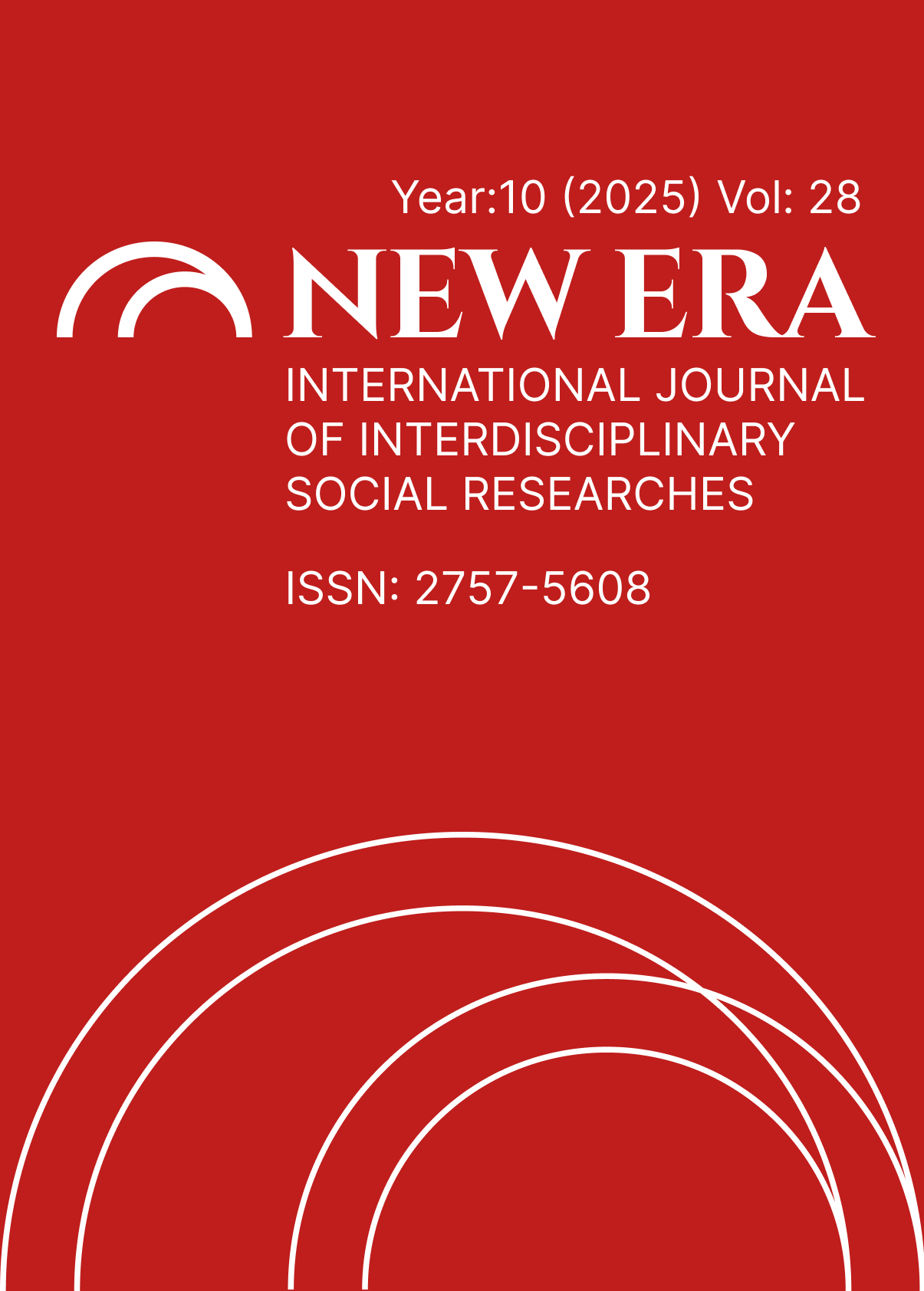INVESTIGATION OF TRADITIONAL PLAN LAYOUT IN DIFFERENT GEOGRAPHICAL REGIONS USING THE SPACE SYNTAX METHOD
DOI:
https://doi.org/10.5281/zenodo.15313514Keywords:
Traditional Housing, Geographical Regions, Space SyntaxAbstract
Housing structures, which are one of the biggest building blocks of the physical environment that reflects the society, appear in a holistic manner with their physical and social dimensions in the urban fabric and in the lives of the citizens, as well as a spatiality that responds to the need for shelter. Many traditional houses have taken their place from past to present in Anatolia, which has hosted many civilizations due to its geopolitical location. Different regions of Anatolia, where various civilizations lived, are the textures in which traditional Turkish residential architecture is reflected.
The space syntax method is a set of techniques developed to examine the spatial textures of cities and building-scale structures, as well as to examine semantic and social dimension relationships. In this direction, the effects of the life of the society living in seven geographical regions on the housing were examined and analyzed in the context of the determined traditional houses, and the abstract and concrete data in the space setup were obtained numerically by the space syntax method. As a result of the data obtained, the effects of the lifestyle and climate in each region on the spatial structure were seen. When the connectivity, integration and beta indices of the house determined in the Eastern Anatolia Region were examined, it was observed that it was the building with the deepest spaces. In addition, we see that the buildings in the Marmara and Black Sea regions have shallower spaces and are social structures.
As a result, by performing morphological analyzes on houses in seven geographical regions, it was determined that spatial evaluations were an important step in analyzing the past and present and transferring them to the future, and it was thought that it would be a basis for making decisions for the right conservation approaches while re-functioning traditional houses.
References
Akkoyunlu, Z. (1989). Geleneksel Urfa Evlerinin Mimarı̂ Özellikleri (Vol. 13). Kültür Bakanlığı.
Akok, M., (1951). Trabzon’un Eski Evleri, Arkitekt Dergisi, 20, 321-325.
Aksoy, F. 17. Ve 18. Yüzyıl Bursa Evleri Yapı Çözümlemesi (Yüksek Lisans Tezi, Mimar Sinan Güzel Sanatlar Üniversitesi, 2011) .
Bacak, F. Antalya İli Akseki İlçesi Emiraşıklar Köyü Geleneksel Konut Dokusunun Ve Koruma Sorunlarının Tespiti ( Yüksek Lisans Tezi, Gazi Üniversitesi, 2019)
Bayram, Ç. (2016). Kültür Merkezlerinin Sosyal Etkileşim Alanlarının Mekansal Dizim Yöntemi İle İrdelenmesi (Doctoral Dissertation, Fen Bilimleri Enstitüsü).
Eldem, S. H. 1972. Türk Evi Plan Tipleri, İTÜ Mimarlık Fakültesi Yayınları, 180-182, İstanbul.
Gökce, D. & Kaya, A. T. (2020). Geleneksel Kırsal Konut Tipolojileri Üzerinden Kültür-Mekân İlişkilerinin Mekân Dizimi Yöntemiyle İncelenmesi: Düzce İli Örneği. Tasarım+ Kuram, 16(31), 36-56.
Günay, R., 1999. Türk Ev Geleneği ve Safranbolu Evleri, Yem Yayınları, 2. Baskı, İstanbul
Hillier B. And J. Hanson. (1997). “The Reasoning Art: Or, The Need For An Analytical Theory Of Architecture,” Space Syntax First International Symposium, London, 01.1-6.
Kara Kamil İletişim Merkezi Arşivi, Eskişehir Odunpazarı Belediyesi-0001-11-29.
Karakaş, S. 2008. Elazığ Geleneksel Konut Kültürü. Yüksek Lisans Tezi, Selçuk Üniversitesi, Fen Bilimleri Enstitüsü.
Kasapbaşı, E. (2018). Gaziantep 1960-1980 Dönemi Kent Konutu Mekân Kurgusunun Analizi (Yüksek Lisans Tezi, Çukurova Üniversitesi, Fen Bilimleri Enstitüsü, Adana).
Kuban, D. S.1992. Mimarlık Kavramları. Yem Yayın, İstanbul.
Kürkçüoğlu, A.C., (2002). Şanlıurfa Mimari Eserlerine Genel Bir Bakış-Şanlıurfa Uygarlığının Doğduğu Şehir, Şurkay Yayını, Ankara.
Maina, J. J. (2014). Discovering Hidden Patterns: An Overview Of Space Syntax Methods İn Architecture And Housing Research. In Department Of Architecture Seminar Series (Pp. 18-33).
Mansouri, A. (2018). İran Tebriz Konutlarında Ana Yaşam Mekanındaki Değişimin Sentaktik İrdelenmesi.
Menderes, F. (2014). Cumhuriyet Döneminde Yerel Yönetim Binalarının Kamusal Erişilebilirlik Açısından Mekân Dizimi (Space Syntax) Yöntemiyle İrdelenmesi (Doktora Tezi, İTÜ Fen Bilimleri Enstitüsü).
Onat, E. S., (1990), “Türk Evi’nin Çağdaş Yaşama Uyarlanması”, Yüksek Lisans Tezi, Y.T.Ü., İstanbul
Özden, Z. Eskişehir Odunpazarı Geleneksel Türk Konut Mimarisi Örnekleri ( Yüksek Lisans Tezi, Mimar Sinan Güzel Sanatlar Üniversitesi, 2009)
Özek Karadeniz, Y. (2010). Geleneksel Afyonkarahisar Evlerinin Sürdürülebilir Mimarlık İlkeleri Bağlamında Değerlendirilmesi. Yüksek Lisans Tezi, Mimar Sinan Güzel Sanatlar Üniversitesi.
Saatçi, M. (2016). Kültürün Mekansal Organizasyona Etkilerinin Mekan Dizim Yöntemi İle Analizi: Laz, Hemşin Ve Gürcü Kültürü Örneği. (Yüksek Lisans Tezi) İstanbul: Yıldız Teknik Üniversitesi Fen Bilimleri Enstitüsü
Sungur, M. (2020). Değişen Sosyal Paradigmaların Mekânsal Mahremiyete Etkileri: Konya Konut Tipolojilerinin Analizi. Doktora Tezi. Konya Teknik Üniversitesi Lisansüstü Eğitim Enstitüsü.
Şahin, Ş. (2010). Ordu Geleneksel Evleri Üzerine Bir Araştırma. Yüksek Lisans Tezi Fen Bilimleri Enstitüsü).
Tazefidan, C. (2018). Sille Evleri’nin Mekânsal Dizim Yöntemi Üzerinden Değerlendirilmesi. Yayımlanmamış Yüksek Lisans Tezi). Konya Selçuk Üniversitesi Fen Bilimleri Enstitüsü.
Downloads
Published
How to Cite
Issue
Section
License
Copyright (c) 2025 NEW ERA INTERNATIONAL JOURNAL OF INTERDISCIPLINARY SOCIAL RESEARCHES

This work is licensed under a Creative Commons Attribution-NonCommercial 4.0 International License.


